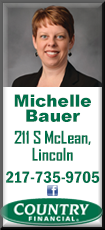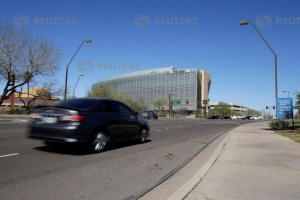Uber seeks OK to resume self-driving tests in
Pennsylvania
 Send a link to a friend
Send a link to a friend
 [November 03, 2018]
By David Shepardson [November 03, 2018]
By David Shepardson
WASHINGTON (Reuters) - Uber Technologies
Inc has asked Pennsylvania for permission to resume self-driving car
testing on public roads and has improved the autonomous vehicle
software, the company said on Friday, more than seven months after it
suspended testing following a deadly crash in Arizona.
The company disclosed in a report to the U.S. National Highway Traffic
Safety Administration that it would resume testing with two employees in
the front seat, enable an automatic braking system at all times, and
more strictly monitor safety employees.
Uber has been testing self-driving cars in manual mode on public
streets.
In June, police in Tempe, Arizona, said a back-up driver behind the
wheel of a self-driving Uber was distracted and streaming a television
show on her phone right up until about the time the car struck and
killed a pedestrian walking across a street, deeming the crash that
rocked the nascent industry "entirely avoidable."

The crash was the first death attributed to a self-driving vehicle and
was seen as a significant setback for the industry, which is racing to
get vehicles into commercial use.
Uber Chief Executive Dara Khosrowshahi said in a statement Friday the
company would resume road tests only after implementing "improved
processes."
Uber said it now has real-time third party monitoring of back-up safety
drivers, sets limits on the time drivers can work per day and has
improved training.
In July, Pennsylvania's Department of Transportation said it was issuing
new guidelines asking companies to submit details about testing, and
that it expected companies would comply.
A spokeswoman for the agency said Friday it had received the application
and would review it.
The state said it would send companies an authorization letter after
approving their submissions. Uber said it would not resume testing in
Pittsburgh until it received that letter.
Alphabet Inc's Waymo <GOOGL.O> unit plans to launch a commercial
ride-hailing service in Arizona this year, while General Motors Co <GM.N>
is on track to roll out a similar service next year with vehicles
without steering wheels or brake pedals.
Authorities in Pittsburgh, where Uber debuted its self-driving vehicles
in 2016, have said they welcome the cars back on city streets.
"I think we have increased confidence," said Karina Ricks, director of
the city's Department of Mobility and Infrastructure, citing the
addition of a second employee in cars being tested and more transparency
from Uber.
Following the Tempe accident, Pittsburgh Mayor Bill Peduto balked at
allowing Uber to resume autonomous driving before a full federal
investigation of the crash.
[to top of second column] |

A car passes the location where a woman pedestrian was struck and
killed by an Uber self-driving sport utility vehicle in Tempe,
Arizona, U.S. March 19, 2018. REUTERS/Rick Scuteri/File Photo

"One of the problems with Uber was they appeared to be moving just a bit too
fast," Ricks said. "They got a little cocky about their technology."
The crash raised significant questions about the performance of Uber's software.
Uber said a key recommendation of an internal review after the Tempe crash was
to improve the self-driving vehicles' "overall software system design." Uber
said in its safety report released Friday the vehicle had improved "system
latency," allowing it to detect objects and actors sooner and execute safe
reactions faster.
The National Transportation Safety Board, which has an ongoing investigation,
said in May that Uber registered observations of the pedestrian about six
seconds before impact, but the system did not determine that emergency braking
was needed until 1.3 seconds before impact.
The NTSB said the vehicle had registered the pedestrian who was walking a bike
across the road first as an unknown object, then a vehicle and lastly a bicycle.
GRAPHIC-How self-driving cars see the road - http://tmsnrt.rs/2FToUeq
Uber said it had a new approach to "handling uncertainty within the self-driving
system." Uber also has a new separate systems engineering testing team and plans
a self-driving safety advisory board of outside experts. If a vehicle is
uncertain about something in its view the software is now better positioned to
"reason over many possible outcomes to ultimately come to a safe response," it
added.

The NTSB also said Uber had disabled an manufacturer-installed automatic
emergency braking system in the 2017 Volvo XC90 while the car was under computer
control in order to "reduce the potential for erratic vehicle behavior."
That braking system is now active whenever Uber is testing on public roads, it
said on Friday. It has also filed a voluntary safety assessment with the
National Highway Traffic Safety Administration on its self-driving efforts and
made public a report from an outside law firm that reviewed the safety culture
at Uber. The agency has an ongoing probe of the Tempe crash.
(Reporting by David Shepardson. Additional reporting by Heather Somerville in
San Francisco.; Editing by Nick Zieminski and Richard Chang)
[© 2018 Thomson Reuters. All rights
reserved.] Copyright 2018 Reuters. All rights reserved. This material may not be published,
broadcast, rewritten or redistributed.
Thompson Reuters is solely responsible for this content. |